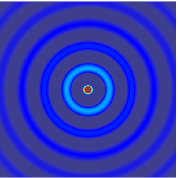
Photo from wikipedia
This paper strictly demonstrated a nonlinear Helmholtz equation, with its corresponding new expressions for the wave number of the mixture, for the propagation of sound trough a bubbly liquid. The… Click to show full abstract
This paper strictly demonstrated a nonlinear Helmholtz equation, with its corresponding new expressions for the wave number of the mixture, for the propagation of sound trough a bubbly liquid. The demonstration was conducted under the assumption of periodicity of volume fluctuations, the acoustic approximation and considering only mono-harmonic pressure oscillations. The model revealed a beautiful symmetry between the average acoustic energy density and the average energy dissipation, as well as between the time average of the first and second derivatives of such fluctuations. The nonlinear model was validated with available experimental data at very low pressure amplitudes yielding the same results as the linear model. However, unlike the linear model, the advantage of the nonlinear model is that the wave number of the mixture is function of the pressure amplitude, which has great implications to model the sound propagation on cavitating bubbly liquids where the linear theory greatly under-predicts.
Journal Title: Ultrasonics sonochemistry
Year Published: 2018
Link to full text (if available)
Share on Social Media: Sign Up to like & get
recommendations!